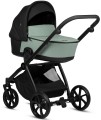Pushchairs in which the carrycot has a foldable design. This feature simplifies the storage and transportation of the stroller, when folded, the
foldable carrycot takes up much less space.
A window made of transparent or translucent material, built into the hood that covers the cradle or seating unit. In the version with a walking block,
the viewing window is usually located so that the parent can see the baby directly while moving, without being distracted from controlling the stroller. In cradles, the parent can see the child through a window by approaching the stroller from the side of the hood (that is, on the opposite side of the handle); implementations with a window in the front hemisphere of the hood are less common. In addition, a baby lying in a cradle can usually see the outside world through the window (primarily the sky above the stroller). The viewing window can be made in the form of oilcloth or a mesh mosquito net, through the holes of which air freely penetrates, but insects and small debris raised by the wind are retained.
The type of wheels installed on the pushchair.
The most popular in our time are
rubber wheels, including
air-filled ones.
Plastic wheels are used mainly in inexpensive pushchairs to further reduce the cost, while
gel ones, on the contrary, are considered a very advanced option.
Polyurethane wheels and
EVA foam-filled wheels are also widely used. Here is a more detailed description of each of these varieties:
— Rubber. Rubber solid tires, found in many modern pushchairs, are popular due to their affordability, quiet operation, and smooth ride over bumps. While less effective on uneven surfaces compared to air-filled and gel wheels, solid rubber tires are cost-effective, low-maintenance, damage-resistant, and suitable for various wheel diameters, including small ones.
— Air-filled. Air-filled rubber tires, commonly featured on pushchairs, offer a softer ride and facilitate easy maneuvering on uneven surfaces and high curbs. Despite their higher cost, they require periodic maintenance to ensure proper pressure and protection against cuts or punctures. However, users find air-filled wheels manageable, as they are thick and less prone to damage.
— Plastic. Plastic wheels, commonly featuring both tire and rim made from this material (thou
...gh some have metal rims), are known for their simplicity and affordability. However, they lack durability, reliability, and effective vibration dampening due to their hardness. Typically found in low-cost pushchairs with small wheels designed for flat surfaces.
— Gel. Wheels similar in design to air-filled tires (see the relevant paragraph), but filled not with air, but with a special gel. The main advantage of this option is its insensitivity to small punctures and cuts: coming out, the gel in the tire in contact with air almost instantly solidifies, effectively sealing the damage. In addition, such wheels are virtually maintenance-free — they do not need to be inflated. The disadvantages of gel tires include high cost and somewhat higher rigidity than air-filled tires (although in terms of softness of running such wheels are still noticeably superior to rubber and even more so to plastic ones).
— Polyurethane. Solid polyurethane tires offer excellent maneuverability, shock absorption, puncture resistance, and durability. They are unaffected by extreme temperature changes and are cost-effective, making them a common choice for various pushchair types.
— EVA. Wheels made of microporous foam rubber, specifically EVA material, offer high elasticity, excellent cushioning, and wear resistance. Lightweight and puncture-resistant, these wheels provide a smooth pushchair ride. However, they may stiffen in cold winter weather.Dimensions of the carrycot provided in the kit.
Partly the rule "the bigger the better" works here: a large carrycot gives a good reserve for the period of growth of the baby, in winter you can put the baby dressed in warm clothes in it, and in summer the extra space in the carrycot provides good ventilation. On the other hand, large carrycots are more bulky, weigh more and cost more.

